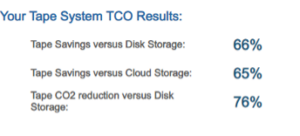
I recently attended a webinar about why IT folks have a love/hate relationship with the cloud. They love the cloud because of its on-demand flexibility, unlimited compute and storage capacity, elimination of CAPEX costs, etc. They hate it, according to the webinar presenter, because of the cost that often produces “sticker shock.” Other irritants might include regulatory compliance issues and cyber security concerns.
To be completely fair to the cloud, the presenter explained that discipline and accountability could be brought to bear to help control costs and that organizations need to establish “a cloud center of excellence.” But at the same time, the presenter showed data from a study that suggested that 58% of respondents were moving some cloud-based workloads back to on-premises, private cloud environments. Finally, the presenter advised the audience to “understand your true cost of IT, TCO tools are out there!”
Getting Back to Hybrid Storage Strategies
I think the overall message of the webinar was that the cloud is great when used for the right applications and that a hybrid approach including a healthy mix of public cloud plus private cloud makes a lot of sense. In fact, the trend prior to COVID-19 appeared to be clearly hybrid. Cloud repatriation was happening as IT managers realized that the cloud is not a panacea for everything. During the COVID period, private cloud data centers were understaffed and under-supported by vendors, so the path of least resistance was to over-leverage the public cloud once again. As we begin to emerge from COVID lockdowns and IT staff returns to the data center, attention is being paid once again to finding a healthy mix of public cloud and on-premises private cloud.
This approach only makes sense and clearly reinforces that it is not an either-or scenario. In the case of storage, the cloud complements on-premises storage including today’s highly advanced and automated tape systems. Cloud comes in handy for example when on-demand access is frequently needed by multiple clients while tape systems can manage less frequently accessed and large data sets needing long-term retention including sensitive data and mission-critical data that can be air-gapped as a cyber security best practice. Tape is particularly well suited for these applications thanks to tape’s:
TCO Tools are Out There
Getting back to the webinar story and the advice to “understand your true cost of IT,” indeed TCO tools are out there and Fujifilm is pleased to offer a free, web-based interactive TCO tool developed by IT economics expert Brad Johns Consulting, LLC. This tool compares 5 year and 10 year TCO of automated tape systems to economy disk systems and cloud-based cold storage. The tool allows users to input the volume of data to be stored, the annual growth rate, the percent of cloud data retrieval as well as other variables such as the local cost per Kwh, the expense of full time storage management staff, number of copies of data, etc. The tool has been available for many years now and has evolved overtime to be as comprehensive as possible and includes the following CAPEX and OPEX cost variables:
Reducing Energy Consumption and CO2 with Tape
Regarding the cost of energy for disk and tape, this expense can be significant over time especially for disk systems that are constantly spinning 24/7 generating heat and therefore require cooling. Given the heightened awareness of global warming and climate change, organizations are looking for ways to reduce energy consumption and their carbon footprint. Data center operations are no exception and have been spotlighted for their energy-intensive applications. Making greater use of renewable energy is part of the answer, but renewable energy can’t come online fast enough, or cheaply enough, to keep up with exponential data growth. Conservation has an even bigger potential to make a difference and that is where tape systems really shine.
Studies show that under certain scenarios inclusive of data management servers and network infrastructure, tape consumes 87% less energy than equivalent amounts of disk storage and therefore produces 87% less CO2 all while reducing TCO by 86% at the same time. Given that data quickly becomes static and frequency of access goes down dramatically after just 30 to 90 days, it makes sense to move that data from energy-intensive and higher cost tiers of storage like flash, performance disk, or even economy disk to lower-cost, energy-efficient tape systems. A good active archive architecture with intelligent data management software is a great way to achieve such storage optimization (getting the right data, in the right place, at the right time, and at the right cost).
To help highlight the energy advantage of tape and its reduction in CO2, the Fujifilm TCO tool now includes a calculation purely focused on the storage hardware layer that shows the reduction in CO2 compared to disk systems, with an example shown below based on storing 5.0 PB for 10 years with 30% annual growth and 12% data retrieval from the cloud.

So not only is TCO reduced with automated tape systems compared to disk and cloud storage, but a meaningful reduction in CO2 can be achieved and that is exactly what we all need to be doing to help slow down the negative impacts of global warming and climate change.
